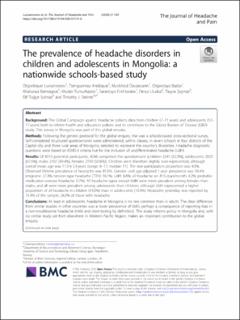| dc.contributor.author | Luvsannorov, Otonbayar | |
| dc.contributor.author | Anisbayar, Tsengunmaa | |
| dc.contributor.author | Davaasuren, Munkhzul | |
| dc.contributor.author | Baatar, Otgonzaya | |
| dc.contributor.author | Batmagnai, Khaliunaa | |
| dc.contributor.author | Turumbaatar, Khulan | |
| dc.contributor.author | Enkhbaatar, Sarantuya | |
| dc.contributor.author | Uluduz, Derya | |
| dc.contributor.author | Sasmaz, Tayyar | |
| dc.contributor.author | Solmaz, Elif | |
| dc.contributor.author | Steiner, Timothy J. | |
| dc.date.accessioned | 2020-10-23T07:48:06Z | |
| dc.date.available | 2020-10-23T07:48:06Z | |
| dc.date.created | 2020-10-01T11:41:50Z | |
| dc.date.issued | 2020 | |
| dc.identifier.citation | The Journal of Headache and Pain. 2020, 21, | en_US |
| dc.identifier.issn | 1129-2369 | |
| dc.identifier.uri | https://hdl.handle.net/11250/2684666 | |
| dc.description.abstract | Background
The Global Campaign against Headache collects data from children (7–11 years) and adolescents (12–17 years) both to inform health and education policies and to contribute to the Global Burden of Disease (GBD) study. This survey in Mongolia was part of this global enquiry.
Methods
Following the generic protocol for the global enquiry, this was a schools-based cross-sectional survey. Self-completed structured questionnaires were administered, within classes, in seven schools in four districts of the Capital city and three rural areas of Mongolia, selected to represent the country’s diversities. Headache diagnostic questions were based on ICHD-3 criteria but for the inclusion of undifferentiated headache (UdH).
Results
Of 4515 potential participants, 4266 completed the questionnaire (children 2241 [52.5%], adolescents 2025 [47.5%]; males 2107 [49.4%], females 2159 [50.6%]). Children were therefore slightly over-represented, although overall mean age was 11.3 ± 3.3 years (range: 6–17; median 11). The non-participation proportion was 4.5%. Observed lifetime prevalence of headache was 81.0%. Gender- and age-adjusted 1-year prevalence was 59.4% (migraine: 27.3%; tension-type headache [TTH]: 16.1%; UdH: 6.6%; all headache on ≥15 days/month: 4.2%; probable medication-overuse headache: 0.7%). All headache types except UdH were more prevalent among females than males, and all were more prevalent among adolescents than children, although UdH represented a higher proportion of all headache in children (13.0%) than in adolescents (10.0%). Headache yesterday was reported by 15.9% of the sample, 26.0% of those with headache.
Conclusions
At least in adolescents, headache in Mongolia is no less common than in adults. The clear difference from similar studies in other countries was a lower prevalence of UdH, perhaps a consequence of reporting bias in a non-troublesome headache (mild and short-lasting by definition). This study informs policy in Mongolia and, with no similar study yet from elsewhere in Western Pacific Region, makes an important contribution to the global enquiry. | en_US |
| dc.language.iso | eng | en_US |
| dc.publisher | BioMed Central | en_US |
| dc.relation.uri | https://thejournalofheadacheandpain.biomedcentral.com/articles/10.1186/s10194-020-01175-6 | |
| dc.rights | Navngivelse 4.0 Internasjonal | * |
| dc.rights.uri | http://creativecommons.org/licenses/by/4.0/deed.no | * |
| dc.title | The prevalence of headache disorders in children and adolescents in Mongolia: a nationwide schools-based study. | en_US |
| dc.type | Peer reviewed | en_US |
| dc.type | Journal article | en_US |
| dc.description.version | publishedVersion | en_US |
| dc.source.volume | 21 | en_US |
| dc.source.journal | The Journal of Headache and Pain | en_US |
| dc.identifier.doi | https://doi.org/10.1186/s10194-020-01175-6 | |
| dc.identifier.cristin | 1836083 | |
| dc.description.localcode | Open Access This article is licensed under a Creative Commons Attribution 4.0 International License, which permits use, sharing, adaptation, distribution and reproduction in any medium or format, as long as you give appropriate credit to the original author(s) and the source, provide a link to the Creative Commons licence, and indicate if changes were made. The images or other third party material in this article are included in the article's Creative Commons licence, unless indicated otherwise in a credit line to the material. If material is not included in the article's Creative Commons licence and your intended use is not permitted by statutory regulation or exceeds the permitted use, you will need to obtain permission directly from the copyright holder. To view a copy of this licence, visit http://creativecommons.org/licenses/by/4.0/. The Creative Commons Public Domain Dedication waiver (http://creativecommons.org/publicdomain/zero/1.0/) applies to the data made available in this article, unless otherwise stated in a credit line to the data. | en_US |
| dc.source.articlenumber | 107 | en_US |
| cristin.ispublished | true | |
| cristin.fulltext | original | |
| cristin.qualitycode | 1 | |

